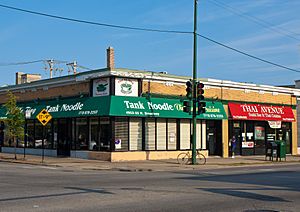West Argyle Street Historic District facts for kids
Quick facts for kids |
|
|
West Argyle Street Historic District
|
|

West Argyle Street, at the Argyle 'L' station
|
|
| Location | Chicago, Illinois |
|---|---|
| Architect | Multiple |
| NRHP reference No. | 10000311 |
| Added to NRHP | June 3, 2010 |
The West Argyle Street Historic District is a special neighborhood in northern Uptown, Chicago, Illinois. It's also known by fun nicknames like Little Saigon, New Chinatown, and Asia on Argyle. This area is called a historic district because it has important buildings and a history that the United States government wants to protect. It was officially added to the National Register of Historic Places on June 3, 2010.
This cool community covers about 41 acres (0.17 square kilometers). Its general borders are N. Glenwood Avenue to the west, Winona Street to the north, Sheridan Road to the east, and Ainslie Street to the south.
Long ago, in the 1920s, this area was home to Essanay Studios. This studio was famous for making movies with the legendary silent film star, Charlie Chaplin. Today, the building that was Essanay Studios is now St. Augustine College.
Contents
A Look Back: The History of Argyle Street
How Argyle Park Began
The area we now call the historic district started as a suburb named Argyle Park in the 1880s. A Chicago city leader and builder named James A. Campbell chose the name. He named it after his family's ancestors, the Dukes of Argyll from Scotland.
The suburb grew around a new train station. This station was part of the Chicago & Evanston line of the Chicago, Milwaukee and St. Paul Railway. It opened in May 1885, making it easier for people to travel.
Joining the City of Chicago
In 1889, the village of Argyle Park, along with the rest of Lake View Township, became part of Chicago. This meant it was no longer a separate small town.
Later, in 1908, the Northwestern Elevated Railroad extended its tracks north. This connected Argyle Park to Chicago's famous 'L' train network. Because of this easy train access, the area became popular. Many people who didn't have a lot of money wanted to live near the beautiful Lake Michigan shore. Between 1914 and 1922, the train tracks were raised onto a special embankment.
The Birth of New Chinatown
In the 1960s, a Chicago restaurant owner named Jimmy Wong had a big idea. He bought land in the Argyle area and wanted to create a "New Chinatown." He imagined a shopping area with beautiful pagodas, trees, and calm reflecting ponds. His goal was to replace the empty stores with a lively new center.
The Hip Sing Association, a Chinese cultural group, moved its Chicago office to Argyle Street in 1971. By 1974, Jimmy Wong and the Hip Sing Association owned most of a three-block stretch on Argyle. Unfortunately, Jimmy Wong had an accident and couldn't continue his big plans.
Then, in 1979, a new leader stepped up. Charlie Soo, who started the Asian American Small Business Association, took over the project. Thanks to his efforts, the area grew into more than just a Chinese neighborhood. It also welcomed businesses from Vietnam, Laos, Cambodia, and Japan.
Charlie Soo worked tirelessly to improve the neighborhood. He convinced the Chicago Transit Authority to give the Argyle 'L' station a $250,000 makeover. In 1981, he started the "Taste of Argyle," which became a popular yearly food festival. He also got money from Chicago Mayor Jane Byrne to fix the sidewalks. Later, Mayor Harold Washington helped with funds to repair building fronts. Because of all his hard work, Charlie Soo became known as the unofficial "Mayor of Argyle Street." By 1986, it was thought that about 8,000 Chinese and Vietnamese people lived in the Uptown area.
Today, Argyle Street is famous for its many Vietnamese restaurants, bakeries, and shops. You'll also find Chinese, Cambodian, Laotian, and Thai businesses. This mix of cultures, centered around the Argyle 'L' station, is why the neighborhood has nicknames like New Chinatown, Little Saigon, or Little Vietnam. On June 3, 2010, this special area was officially added to the National Register of Historic Places.





